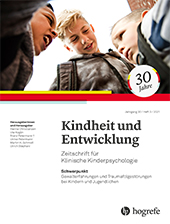Abstract
Zusammenfassung.Theoretischer Hintergrund: Dysfunktionale posttraumatische Kognitionen über das Selbst und die Welt als Folge traumatischer Erfahrungen können die Entwicklung einer posttraumatischen Belastungsstörung begünstigen. Fragestellung: Diese Studie untersucht das Wirkgeflecht zwischen der Art des traumatischen Ereignisses (interpersonell/akzidentiell), posttraumatischen Kognitionen und posttraumatischen Belastungssymptomen in Kindheit und Jugend. Methode: Erhoben wurden Daten von N = 48 Jugendlichen (9 – 17 Jahren) mittels Selbstbericht. Ergebnisse: Die Mediationsanalyse zeigte, dass posttraumatische Kognitionen als signifikanter Mediator für interpersonelle im Vergleich zu akzidentiellen Erfahrungen wirkten. Diskussion: Die Ergebnisse zeigen, dass mit interpersonellen Traumata konfrontierte Kinder und Jugendliche in besonderem Maße Erschütterungen des Selbst- und Weltbildes ausgesetzt sind. Die Erkenntnisse betonen die Bedeutung kognitiver Elemente in der Traumatherapie mit Kindern und Jugendlichen.
Abstract.Theoretical background: Dysfunctional posttraumatic cognitions refer to negative appraisals of traumatic events and their sequelae, for example, to the sense of permanent and disturbing change or of being a fragile person in a scary world. Previous research demonstrated that such dysfunctional cognitions can lead to a sense of current threat and impact the development and maintenance of posttraumatic stress disorder including symptoms of re-experiencing, avoidance, negative alterations in cognitions and mood, and hyperarousal. Furthermore, the type of traumatic events was found to be a risk factor for posttraumatic stress symptoms. While both accidental and interpersonal experiences can be potentially traumatic, there is a higher risk of developing posttraumatic stress disorder following interpersonal events. Objective: This study investigates the association between type of traumatic events (interpersonal or accidental), dysfunctional posttraumatic cognitions, and posttraumatic stress symptoms in children and adolescents. Method: The sample included N = 48 children and adolescents between 9 and 17 years (M = 14.53, SD = 1.64, 69 % female). Participants were recruited through child-welfare services. All children and adolescents in the sample lived in out-of-home care. We collected data using standardized self-report measures assessing potentially traumatic experiences, posttraumatic stress symptoms, and dysfunctional posttraumatic cognitions. The data were analyzed using statistical mediation models including the index trauma type as the dichotomous independent variable (accidental or interpersonal), posttraumatic cognitions as the mediator, and posttraumatic stress symptoms as the dependent variable. Results: More than half of the children and adolescents in the sample reported interpersonal potentially traumatic experiences (70.8 %; n = 34) as an index event. Screening for posttraumatic stress disorder showed that 54.2 % (n = 26) had clinically relevant posttraumatic stress symptoms that might require additional diagnostics and treatment. The mediation analysis showed that dysfunctional posttraumatic cognitions explained a large part of the variance of posttraumatic stress symptoms (87.1 %). Those children and adolescents who experienced interpersonal index traumatic events showed significantly higher levels of dysfunctional posttraumatic cognitions than participants who reported an accidental index trauma. Dysfunctional posttraumatic cognitions had a significant mediating role when explaining the relationship between interpersonal traumatic experiences compared to accidental events and posttraumatic stress symptoms. A closer look at Cluster D showed that the mediation effect was significant when explaining posttraumatic stress symptoms of alterations in cognitions and mood as well as just alterations in mood. Discussion and conclusion: The findings indicate that interpersonally traumatized children and adolescents are prone to develop negative cognitions about themselves and the world which could lead to posttraumatic stress symptoms. The findings emphasize the importance of cognitive elements in trauma therapy, especially for children and adolescents with interpersonal traumatic experiences.
Literatur
(2014). Rates of post-traumatic stress disorder in trauma-exposed children and adolescents: meta-analysis. The British Journal of Psychiatry, 204, 335 – 340.
(2013). Diagnostic and Statistical Manual of Mental Disorders (5th ed.). Washington, DC: APA.
(1986). The moderator-mediator variable distinction in social psychological research: Conceptual, strategic and statistical considerations. Journal of Personality and Social Psychology, 51, 1173 – 1182. https://doi.org/10.1037/0022-3514.51.6.1173
(2019). Klinisch-psychologische Diagnostik in einer Flüchtlingsambulanz für Kinder und Jugendliche. Erste Ergebnisse zu psychischen Belastungen, traumatischen Lebensereignissen und Behandlungszielen. Kindheit und Entwicklung, 28, 160 – 172.
(2007). A prospective study of appraisals in childhood posttraumatic stress disorder. Behaviour Research and Therapy, 45, 2502 – 2507. https://doi.org/10.1016/j.brat.2007.04.009
(2009). Traumafokussierte kognitive Verhaltenstherapie bei Kindern und Jugendlichen. Berlin: Springer.
(2016). Psychometric Properties of the German Version on the Child Post-Traumatic Cognitions Inventory (CPTCI-GER). Child Psychiatry & Human Development, 47, 151 – 158. http://doi.org/ 10.1007/s10578-015-0552-0
(2019). Do dysfunctional posttraumatic cognitions play a mediating role in trauma adjustment? Findings from interpersonal and accidental trauma samples of children and adolescents. European Journal of Psychotraumatology, 10:1. http:://doi.org/10.1080/20008198.2019.1596508
(2000). A cognitive model of posttraumatic stress disorder. Behaviour Research and Therapy, 38, 319 – 345.
(2019). The relationship between maladaptive appraisals and posttraumatic stress disorder: A meta-analysis. European Journal of Psychotraumatology, 10, 1620084.
(2013). PROCESS macro (Version 3.3) [Plug-in]. New York City, NY: Author.
(2012).
KVT bei Posttraumatischer Belastungsstörung . In A. A. Schlarb (Hrsg.), Praxishandbuch KVT mit Kindern und Jugendlichen: Störungsspezifische Strategien und Leitfäden (S. 251 – 279). Weinheim: Beltz.(2019). A core role for cognitive processes in the acute onset and maintenance of post-traumatic stress in children and adolescents. Journal of Child Psychology and Psychiatry, 60, 875 – 884. https://doi.org/10.1111/jcpp.13054
(2009). Development and validation of the child post-traumatic cognitions inventory (CPTCI). Journal of Child Psychology and Psychiatry, and Allied Disciplines, 50, 432 – 440. https://doi.org/10.1111/j.1469-7610.2008.01995.x
(2017). A Meta‐Analysis of the Association Between Appraisals of Trauma and Posttraumatic Stress in Children and Adolescents. Journal of Traumatic Stress, 30, 88 – 93. https://doi.org/10.1002/jts.22157
(2016). International development and psychometric properties of the child and adolescent trauma screen (CATS). Journal of Affective Disorders. 210, 189 – 195. https://doi.org/10.1016/j.jad.2016.12.040
(1991). Childhood traumas: An outline and overview. American Journal of Psychiatry, 148, 10 – 20.
(2012). A meta-analysis of risk factors for post-traumatic stress disorder in children and adolescents. Clinical Psychology Review, 32, 122 – 138.



